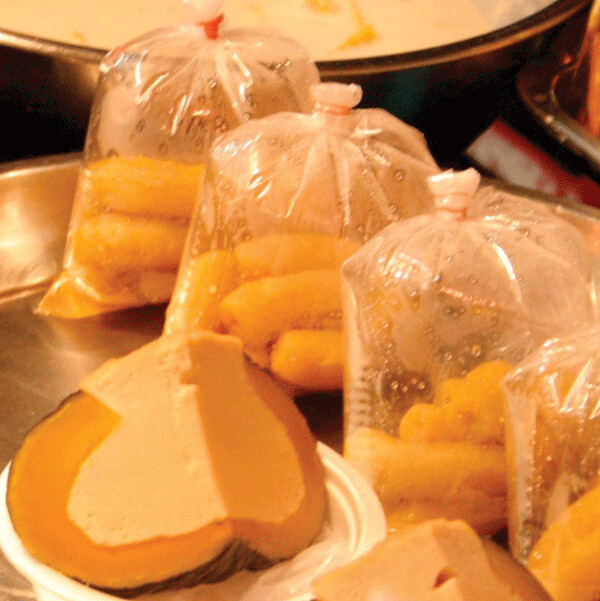Pumpkin Pie, Thai-style

The Thai dessert sangkaya is a steamed squash filled with coconut custard. It may not sound like pie, but anyone who likes a good slice of pumpkin pie should be very interested in this dish.
I first came across sangkaya at a night market in Bangkok. Taking in the tapioca balls, syrups, fried goodies and brightly colored jellies of a dessert vendor, I noticed a squash that was sliced into four wedges, revealing a white custard filling. I bought a wedge. The combination of sweet, starchy squash flesh and creamy coconut custard reminded me of pumpkin pie, as it turned my concept of pumpkin pie inside out.
Pumpkin pie filling, after all, is basically spiced pumpkin custard. This pumpkin Thai, as I call sangkaya, is basically a deconstructed pumpkin pie, minus the crust, and pie spices like cinnamon and nutmeg.
While most pumpkin pies contain vanilla, sangkaya contains pandan leaf, which has a similarly warm, sweet fragrance. Like vanilla, pandan leaf doesn’t actually taste sweet, but has an aroma that goes well with sweet things.
Since every squash is a different size, and some types take longer to cook than others, giving a one-size-fits-all cooking time recommendation is difficult. Making it even more complicated is the fact that different squashes have different sized body cavities, resulting in different custard thickness. Because it’s easy to overcook the squash while you fret about the custard not setting up, or vice-verse, you should make this a few times in private with the squash you have available, before unveiling it to others. The good news is that almost any of the potential pitfalls and failures are entirely edible, so you can eat the leftovers. If all you want is something delicious to eat, this recipe is a snap. But to make something pretty requires more artifice.
Rinse the outside of a squash. Trim the bottom, if necessary, to make it sit flat and not roll over. Then cut out the stem end of the squash, making a round or square hole as you would when carving a jack-o-lantern, and scrape out the seeds and membranes on the inside. Kabocha squash is typically used, but acorn, delicata, buttercup and many others work too.
To make the custard, begin by mixing a cup of coconut cream with a cup of sugar, and heat them gently until the sugar dissolves and it becomes a smooth mixture. Coconut cream can be purchased as such. Alternatively, a typical can of coconut milk will separate into thick cream and a thin, low-fat milk. It may take two cans of coconut milk to glean a cup of coconut cream. As for the sugar, coconut or palm sugars are the most authentic, but sugar from sugarcane or beets will do the job.
Allow the mixture to cool to room temperature. Beat five eggs and mix them with the cooled mixture. Add a half-teaspoon of vanilla, and strain the mixture through cheesecloth or a wire mesh to remove any bubbles, and pour it into your hollowed squash, up to within an inch of the top.
Pour any extra custard into a ramekin or other heat-proof dish and make steamed coconut custard.
Place the squash in a steamer, and steam. Larger squashes should be supported by a wide bowl; one pitfall in making this dish is to cook the squash to the point where it’s too soft and slumps over.
It could take up to an hour for the custard to set in a larger squash; as little as 20 minutes for a cup of custard.
After about 40 minutes, check to see if the custard has set. The custard will have expanded over the top and plugged the hole you created, making this dish over the top in more ways than one.
Insert a butter knife deep into the custard and try to wag it back and forth like a paddle. If it moves easily, or if liquid comes out the knife hole, the custard isn’t done. Keep steaming, checking every ten minutes until the knife won’t paddle.Turn off the heat and allow to cool.
When the squash cools, cut it into wedges as you would a pie, and serve.
